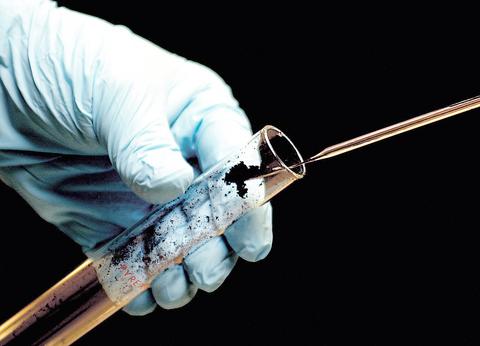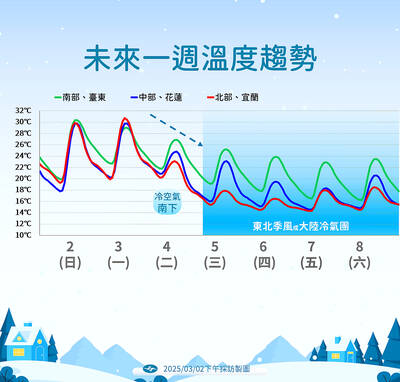Those stain-resistant khakis you just picked up at the mall, the tennis ball that holds its bounce longer and sunscreen that's clear instead of white have something in common -- nanotechnology.
Scientists manipulating matter at the molecular level have improved on hundreds of everyday products in recent years and are promising dramatic breakthroughs in medicine and other industries as billions of dollars a year are pumped into the nascent sector.
But relatively little is known about the potential health and environmental effects of the tiny particles -- just atoms wide and small enough to easily penetrate cells in lungs, brains and other organs.

PHOTO: NY TIMES NEWS SERVICE
While governments and businesses have begun pumping millions of dollars into researching such effects, scientists and others say nowhere near enough is being spent to determine whether nanomaterials pose a danger to human health.
Michael Crichton's bestselling book Prey paints a doomsday scenario in which a swarm of tiny nanomachines escapes the lab and threatens to overwhelm humanity. Scientists believe the potential threat from nanomaterials is more everyday than a sci-fi thriller, but no less serious.
Studies have shown that some of the most promising carbon nanoparticles -- including long, hollow nanotubes and sphere-shaped buckyballs -- can be toxic to animal cells. There are fears that exposure can cause breathing problems, as occurs with some other ultrafine particles, that nanoparticles could be inhaled through the nose, wreaking unknown havoc on brain cells, or that nanotubes placed on the skin could damage DNA.
The US National Institute for Occupational Safety and Health is developing guidelines for working with nanomaterials, saying the tiny particles may raise health concerns and the risk to those who work with them is unknown.
Also unknown is the risk to consumers and the environment.
"No one knows, and that's the problem," said Pat Roy Mooney, executive director of the ETC Group, an Ottawa-based nonprofit that studies the impact of technology on people and the environment. "People are rubbing them on our skin as sunscreens and as cosmetics."
Mooney's group is calling for products, such as sunscreen, that are directly absorbed into the body to be taken off the shelf until there is more study.
"Frankly, I don't think that skin creams or stain resistant pants or food additives are a good reason to sacrifice someone's health," he said.
The federal government currently spends about US$1 billion a year on nanotechnology research under its National Nanotechnology Initiative.
A newly released inventory by the Project on Emerging Nanotechnologies found about US$6 million being spent annually by the federal government on research that is highly focused on health and environmental effects of nanotechnology. Though the inventory is not a complete accounting of all research, it indicates that a small percentage of research dollars are going to health and safety, said Dave Rejeski, director of the non-partisan policy group.
"More energy and more funding needs to go into it," said Kevin Ausman, executive director of the Center for Biological and Environmental Nanotechnology at Rice University in Texas.
"There is not going to be a simple answer to the question `Is nanotechnology dangerous?'" he said.
But Ausman and others said the nanotechnology sector is ahead of the curve when it comes to understanding potential dangers, and is doing far more early research than has been done in other industries, even one as relatively new as biotechnology.
"These issues are being discussed openly," said Agnes Kane, a pathologist at Brown University, who is moving into nanotechnology after extensive work researching asbestos. She is one of several Brown professors sharing a US$1.8 million, four-year grant to study the effects of nanoparticles on human and animal cells.
The asbestos industry, which doled out staggering sums of money for liability lawsuits after material used for insulation was shown to cause cancer and other ailments, paid the price for a failure to fully understand the product's dangers before putting it on the market, Kane said.
"This is one of the few areas that I've been in that there has been a discussion at the beginning," she said.
Rejeski said researchers are struggling with how much to spend and how to decide what research to fund. The group's inventory of research is a kind of "nanotech dating service" that can help match up researchers with similar interests who are looking for partners, he said.
It can also identify holes and point to areas that need more funding. For example, a search of the inventory shows much of the research now happening is focused on the lungs. Very little is focused on the gastrointestinal tract -- even though there are new toothpastes being developed that use nanotechnology, Rejeski said.
There's also very little so-called lifecycle research -- how nanomaterials break down in the environment, Rejeski said.
Scientists are also working on creating a standard terminology for nanotechnology so that researchers from different backgrounds can work together and better understand the research that's been done in other fields.
The NanoBusiness Alliance, a group of large and small businesses, is looking at working with other groups to conduct an economic analysis of the level of funding that is needed for environmental health and safety research in the coming year. The alliance consists primarily of nanotech startups but also includes major corporations such as Lockheed Martin and Motorola and research institutions including Northwestern and Purdue universities.
Sean Murdock, executive director of the group, said he believes it's premature to regulate the young industry but that businesses recognize that more health and safety research is needed.
"If we keep our eye on the ball," he said, "we can avoid big downstream problems."

SECURITY: The purpose for giving Hong Kong and Macau residents more lenient paths to permanent residency no longer applies due to China’s policies, a source said The government is considering removing an optional path to citizenship for residents from Hong Kong and Macau, and lengthening the terms for permanent residence eligibility, a source said yesterday. In a bid to prevent the Chinese Communist Party (CCP) from infiltrating Taiwan through immigration from Hong Kong and Macau, the government could amend immigration laws for residents of the territories who currently receive preferential treatment, an official familiar with the matter speaking on condition of anonymity said. The move was part of “national security-related legislative reform,” they added. Under the amendments, arrivals from the Chinese territories would have to reside in Taiwan for

CRITICAL MOVE: TSMC’s plan to invest another US$100 billion in US chipmaking would boost Taiwan’s competitive edge in the global market, the premier said The government would ensure that the most advanced chipmaking technology stays in Taiwan while assisting Taiwan Semiconductor Manufacturing Co (TSMC, 台積電) in investing overseas, the Presidential Office said yesterday. The statement follows a joint announcement by the world’s largest contract chipmaker and US President Donald Trump on Monday that TSMC would invest an additional US$100 billion over the next four years to expand its semiconductor manufacturing operations in the US, which would include construction of three new chip fabrication plants, two advanced packaging facilities, and a research and development center. The government knew about the deal in advance and would assist, Presidential

‘DANGEROUS GAME’: Legislative Yuan budget cuts have already become a point of discussion for Democrats and Republicans in Washington, Elbridge Colby said Taiwan’s fall to China “would be a disaster for American interests” and Taipei must raise defense spending to deter Beijing, US President Donald Trump’s pick to lead Pentagon policy, Elbridge Colby, said on Tuesday during his US Senate confirmation hearing. The nominee for US undersecretary of defense for policy told the Armed Services Committee that Washington needs to motivate Taiwan to avoid a conflict with China and that he is “profoundly disturbed” about its perceived reluctance to raise defense spending closer to 10 percent of GDP. Colby, a China hawk who also served in the Pentagon in Trump’s first team,

The arrival of a cold front tomorrow could plunge temperatures into the mid-teens, the Central Weather Administration (CWA) said. Temperatures yesterday rose to 28°C to 30°C in northern and eastern Taiwan, and 32°C to 33°C in central and southern Taiwan, CWA data showed. Similar but mostly cloudy weather is expected today, the CWA said. However, the arrival of a cold air mass tomorrow would cause a rapid drop in temperatures to 15°C cooler than the previous day’s highs. The cold front, which is expected to last through the weekend, would bring steady rainfall tomorrow, along with multiple waves of showers